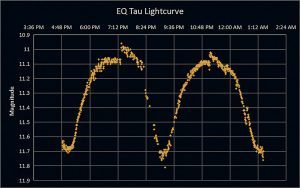 By Karl Fiteni
By Karl Fiteni
An astronomer’s task is to provide insight into the nature of the universe through the observation of celestial objects. Stars are usually a few hundred, or even thousands, of light-years away—a problematic distance for direct study. Instead, people can study the light emitted by the star rather than the star itself.
Stars are immensely important as engines of cosmic evolution. They play a key role in the creation of elements heavier than hydrogen and helium, the elements which, in turn, make up humans and the world we live in. Stars and their planets are the only places we are likely to find other life in the universe. Variable stars are a class of stars which undergo a change in brightness over time. Research on variable stars is important because it provides information about stellar properties such as mass, radius, luminosity, temperature, internal and external structure, composition, and evolution. In many cases, it is the nature of the variability that provides the clues that answer our big questions: Where did we come from?

For my undergraduate dissertation, (supervised by Dr Joseph Caruana) I used astronomical equipment from the Institute of Space Sciences and Astronomy (ISSA, University of Malta) to carry out photometric measurements on variable stars. I captured hundreds of images of stars over multiple nights for the purpose of representing the data as light-curves: plots of the stars’ brightness against time. The main aim was to obtain measurements to characterise the level of brightness changes which can be detected in variable stars, using a fairly small 0.25m aperture telescope and a basic CCD (Coupled Charged Device) camera.
Despite its success, the project was challenging. Firstly, deriving a light-curve from raw observational data proved difficult, requiring the reduction of a fair deal of scientific data along with the careful analysis of astronomical observations, both of which are fundamental aspects of observational astronomy. Light pollution was also a hurdle, however this was an opportunity to recognise what kind of observations are possible around the Maltese Islands.
The skills garnered through this work will help not only pave the way for future photometric measurements using more sophisticated equipment, but, more importantly, it will allow us to gain insight into more elusive astronomical events that are just beyond our grasp. The big questions will be answered… we just need the right tools.





Comments are closed for this article!